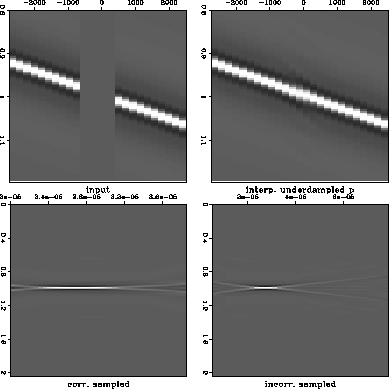Alternatively, changing geometrical bases can be viewed as estimating
missing data from known data.
Subscripts m denote missing and k denote known data or model values.
Identifying ![]() with the known portion and
with the known portion and ![]() with the
unknown portion
of the data, we see directly that equation (3) is an estimation
of unknown data (at the new geometry).
with the
unknown portion
of the data, we see directly that equation (3) is an estimation
of unknown data (at the new geometry).
| |
(4) |
| |
(5) |
Given a line in x-t with a gap in the middle, it is easy to demonstrate the null space problem. We run into that problem when the domain is not finely enough sampled in p, or in other words the model space is underdetermined.
Figure ![[*]](http://sepwww.stanford.edu/latex2html/cross_ref_motif.gif) shows a line with a bandlimited spike. The
least squares
forward transform incorporates the information about the gap into the operator.
The slant stack domain shows clearly a single spike for the properly sampled
data.
shows a line with a bandlimited spike. The
least squares
forward transform incorporates the information about the gap into the operator.
The slant stack domain shows clearly a single spike for the properly sampled
data.
 |